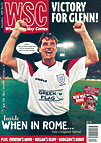 Roger Titford examines how ground advertising is becoming a much more visible part of the matchday experience in recent times
Roger Titford examines how ground advertising is becoming a much more visible part of the matchday experience in recent times
The move from commercial innocence to commercial overload has radically affected what the fan sees inside a football ground nowadays. All the clutter that is on display now seriously infringes on the beauty of football as a visual spectacle, especially when looking at one end of the ground from the other.
Gone are the big, simple solids of browny-black crowd mass, wreathed in winter in smoke and steam, the low unadorned walls and the brightly clad players standing out dramatically from the surrounding murk.
Instead today the eye is caught by many fragments of irrelevant colour: stewards in yellow bibs, stewards in orange bibs, revolving pitchside ads, flashing scoreboard ads, ten thousand people at the other end of the stadium all dressed in the same red shirt as the ten out there on the pitch somewhere, multi-coloured goalkeeper’s jerseys that stand out less than the old plain green and logos, logos everywhere.
It all dampens the presence of the players and diminishes the sense of space. Modern press photography with its love of the close-up telephoto shot minimizes the effect, it is more noticeable on television, but the paying spectator bears the biggest burden.
Though Spurs, Arsenal and Wolves to name but three did not have any perimeter hoarding 30 years ago advertising has long been a part of football grounds, with Bovril a major participant as seen above at Villa in the 1920s. During the Second World War years all advertising for brands ceased and many football grounds became bare, as the picture from Turf Moor (top left) in 1967 shows.
Some advertisements were of a monumental nature, as evidenced by this wholehearted endorsement of M&B at Birmingham City’s Railway End (bottom left). These types of adverts eventually became part of the scenery, the fabric of the place. The West Reading Laundry hoarding, erected behind an Elm Park terrace at the instigation of a director in the late 1940s, blotted out the daylight from nearby houses for a good 25 years.
Ads on the pitched roofs of old-style stands also had unusual longevity: John Smiths Bitter at Barnsley; Ismail and Co. Cafe at Blackpool, now finally gone; and the Peter Shilton of them all, the Captain Morgan Rum (‘for the taste of today’) at Cardiff, faded but impossible to remove.
There really were Viz-style ads that ran the length of the roof, like ‘Dine at the Pack Horse Restaurant, Nelson Square, Bolton’ and ‘After a good match enjoy a good tea at Pictons in the Butts’ at Reading. They were direct and potentially useful, unlike another school of ads, the overwordy poster as shown here in 60s Watford (bottom middle) which, at its worst (Bolton in the mist!) gave chapter and verse on some kind of flange rivet. Even a Snickers ad makes more sense.
Today’s most horrendous offering is probably the hoarding that has replaced the terrace behind a goal at Leyton Orient. It offers a blown-up version of what looks like the innards of Exchange & Mart. It must be hell to look at from the other end and unlikely to be much value to the people who have paid for space on it.
The future probably holds more horrors still. The ghastly, but oh so impactful, 3D style ads that are placed behind the posts at international rugby (thank you Royal Bank of Scotland, that put me off forever) have yet to make their football debut. Some away kits look unduly influenced by the sponsors livery (for instance Carlisle as eleven Eddie Stobart lorries, and a few suspicions about recent Liverpool kit and a case of Carlsberg).
For the TV viewer there may yet be the delights of quarter time and strip ads running verbal messages along the bottom of the screen while matches are in progress. The only consolation is that the human eye and brain is relatively good at screening out irrelevant information.
From WSC 130 December 1997. What was happening this month